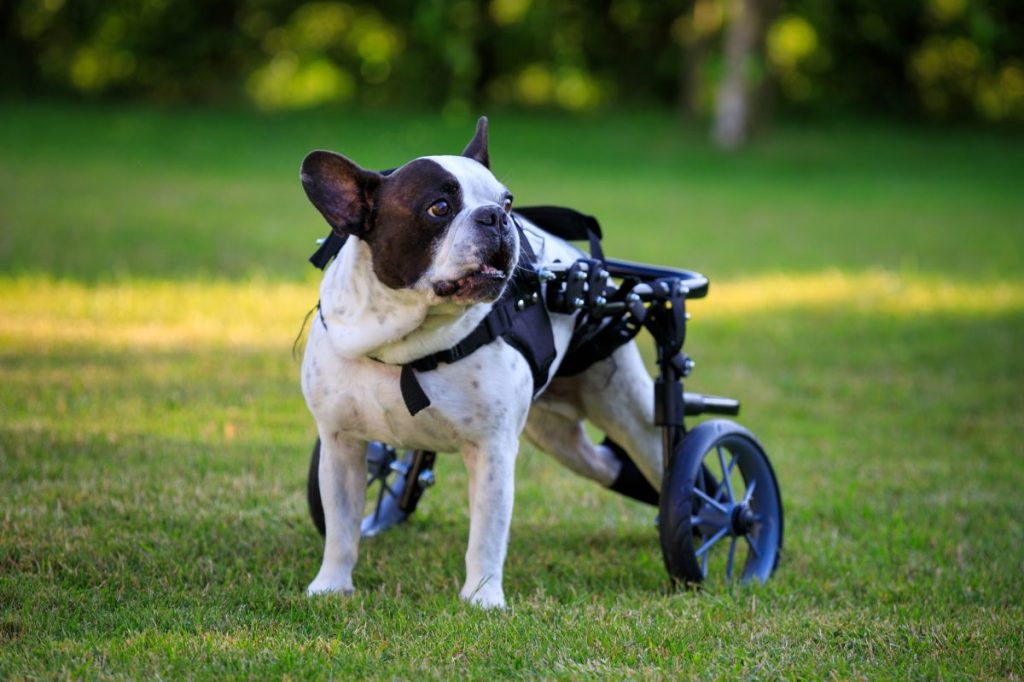Spina bifida in dogs is a congenital condition that occurs when a dog’s spine and spinal cord fail to develop properly during early gestation. This condition belongs to a group of disorders known as neural tube defects. The neural tube is the embryonic structure that eventually develops into a dog’s brain, spinal cord, and the tissues that enclose them. When part of the neural tube fails to close all the way, the result is spina bifida. As such, it is a relatively rare condition, primarily occurring in the lumbar or sacral regions of the spine.
Spina bifida in dogs can be classified into three forms:
- Spina bifida occulta: This is the mildest form, where there may be a small dimple or hair tuft on a dog’s back, signaling the spot of the spinal column defect. Dogs with spina bifida occulta may show no symptoms or very mild ones.
- Spina bifida with meningocele: In this type, there is a sac-like protrusion containing cerebrospinal fluid and meninges — the protective covering of the spinal cord — through an opening in the vertebrae. This form may or may not involve the spinal cord itself.
- Spina bifida with meningomyelocele: This is the most severe form, where a sac-like protrusion contains cerebrospinal fluid, meninges, and a portion of the spinal cord itself — which may be exposed or covered by a thin layer of skin. This form often leads to more significant neurological problems and requires immediate medical attention.
Here’s what you should know about the symptoms, causes, and treatments for the condition.
Symptoms of spina bifida in dogs

The symptoms of spina bifida in dogs can vary significantly depending on the severity and location of the defect in the spine. In mild cases, there may be little to no noticeable symptoms. However, more severe cases can lead to significant physical and neurological issues. Common signs include:
- Weakness or paralysis in the hind legs
- Incontinence
- Abnormal gait
- Visible deformity
- Lack of sensation
These signs usually become evident as a puppy grows and becomes more active. If you observe any of these symptoms, it’s crucial to consult with a veterinarian who can assess your dog and provide an accurate diagnosis.
Spina bifida in dogs can often accompany secondary congenital defects. These may include:
- Meningomyelocele: Protrusion of the meninges and/or spinal cord, sometimes with fluid-filled pockets
- Hemi- or block vertebrae: Irregularly shaped vertebrae
- Hydrocephalus: Buildup of excess fluid in the skull, leading to brain swelling
- Dermoid sinus: Tubular sac that extends from the skin to deeper tissues
Causes of spina bifida in dogs
The primary cause of spina bifida is genetic. Consequently, certain breeds may be more susceptible to this condition. These include:
- English Bulldogs
- French Bulldogs
- Collies
- Dobermans
- Boston Terriers
- Miniature Poodles
- Chihuahuas
- English Cocker Spaniels
In addition, males are more commonly affected than females. Genetic predisposition combined with environmental factors — such as exposure to toxins or poor nutrition during pregnancy — can increase the risk of a puppy developing spina bifida.
It is also speculated that vitamin deficiencies, particularly folic acid in the diet of a pregnant dog, might contribute to the development of neural tube defects like spina bifida in puppies. This insight comes from human medical research, which shows a significant reduction in neural tube defects when folic acid is supplemented before conception and during pregnancy. Although direct evidence in dogs is limited, it points towards the importance of a well-balanced diet during pregnancy.
If you suspect your dog might be affected by spina bifida, it’s crucial to seek a diagnosis from your veterinarian. The diagnosis process typically involves a thorough physical examination, followed by advanced imaging techniques such as X-rays or MRI scans. These imaging tests can help visualize the extent of the spinal issue and any other abnormalities that may be present. Your vet might also suggest blood tests to rule out other conditions that could be causing similar symptoms.
Treatments for spina bifida in dogs

Various treatments and supportive care can help manage the symptoms of spina bifida and improve the quality of life for affected dogs. Treatment plans are often tailored to your individual dog’s needs and may include:
- Surgical intervention: In some cases, especially with milder forms of spina bifida, surgery can help correct the defect and protect the spinal cord from further damage.
- Physical therapy: Physical rehabilitation can help strengthen the muscles and improve mobility in dogs with spina bifida. This is especially useful for managing weakness or paralysis in the hind legs.
- Medications: For managing incontinence and other related symptoms, your veterinarian may prescribe certain medications to improve bladder and bowel control.
- Assistive devices: If your dog has mobility issues, wheelchairs or supportive harnesses can make a big difference in quality of life, allowing them to move more freely.
- Regular monitoring and care: Regular vet check-ups are crucial to monitor the condition and adjust treatments as necessary. Moreover, preventing obesity and keeping the skin around the affected area clean are vital components of care.
There is no cure for spina bifida, so the focus is often on managing symptoms and preventing complications. This means creating an environment that accommodates your dog’s needs, such as having non-slip surfaces to aid mobility or adjustments to their living space to make it easier for them to get around. Additionally, giving your dog joint supplements like Cosequin, Dasuquin, and Welactin — along with providing a well-balanced, high-quality diet — can help decrease inflammation and promote healthy joints. However, always remember to consult your veterinarian before implementing any new treatments or dietary changes.









